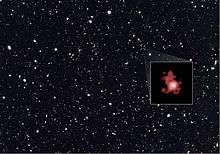GN-z11
| GN-z11 | |
|---|---|
 GN-z11 superimposed on an image from the GOODS-North survey | |
| Observation data (J2000[1] epoch) | |
| Constellation | Ursa Major[1] |
| Right ascension | 12h 36m 25.46s[1] |
| Declination | +62° 14′ 31.4″[1] |
| Redshift |
11.09+0.08 −0.12[2] |
| Distance | ~32 billion ly (9.8 billion pc) |
| Characteristics | |
| Type | Galaxy |
| Mass | ~1×109 M☉ |
| Size | 4,000 ± 2,000 ly (1,200 ± 610 pc)[2] |
| Other designations | |
| GN-z10-1[2] | |
GN-z11 is a high-redshift galaxy found in the constellation Ursa Major. GN-z11 is currently the oldest and most distant known galaxy in the observable universe.[3] GN-z11 has a spectroscopic redshift of z = 11.09, which corresponds to a proper distance of approximately 32 billion light-years (9.8 billion parsecs) from Earth.[4][note 1]
The object's name is derived from its location in the GOODS-North field of galaxies and its high Doppler z-scale redshift number (GN + z11).[5] GN-z11 is observed as it existed 13.4 billion years ago, just 400 million years after the Big Bang;[2][6] as a result, GN-z11's distance is widely (and mistakenly)[7] reported as 13.4 billion light years.[8][9]
Discovery
The galaxy was identified by a team studying data from the Hubble Space Telescope's Cosmic Assembly Near-infrared Deep Extragalactic Legacy Survey (CANDELS) and Spitzer Space Telescope's Great Observatories Origins Deep Survey-North (GOODS-North).[10][11] The research team used Hubble's Wide Field Camera 3 to measure the distance to GN-z11 spectroscopically, by splitting the light into its component colors to measure the redshift caused by the expansion of the universe.[12] The findings, which were announced in March 2016, revealed the galaxy to be farther away than originally thought, at the distance limit of what the Hubble Telescope can observe. GN-z11 is around 150 million years older than the previous record-holder EGSY8p7,[5] and is observed (shortly after but) "very close to the end of the so-called Dark Ages of the universe",[12] and (during but) "near the very beginning" of the reionization era.[10]
Compared with the Milky Way galaxy, GN-z11 is twenty-five times smaller, has 1% of the mass, and is forming new stars approximately twenty times faster.[12] With a stellar age estimated at 40 million years, it appears the galaxy formed its stars relatively rapidly.[2] The fact that a galaxy so massive existed so soon after the first stars started to form is a challenge to some current theoretical models of the formation of galaxies.[10][12]
Notes
- ↑ At first glance, the distance of 32 billion ly (9.8 billion pc) might seem impossibly far away in a Universe that is only 13.8 billion (short scale) years old, where a light year is the distance light travels in a year, and where nothing can travel faster than the speed of light. However, because of the expansion of the universe, the distance of 13.4 billion light years traveled by light from GN-z11 to Earth, called the light-travel distance, has expanded to a distance of 32 billion light-years during the 13.4 billion years it took the light to reach us. See: Size of the observable universe, Misconceptions about the size of the Observable universe, and Measuring distances in expanding space.
References
- 1 2 3 4 "Hubble Team Breaks Cosmic Distance Record - Fast Facts". HubbleSite. March 3, 2016. STScI-2016-07. Retrieved March 4, 2016.
- 1 2 3 4 5 Oesch, P. A.; Brammer, G.; van Dokkum, P.; et al. (March 2016). "A Remarkably Luminous Galaxy at z=11.1 Measured with Hubble Space Telescope Grism Spectroscopy". The Astrophysical Journal. 819 (2). 129. arXiv:1603.00461
 . Bibcode:2016ApJ...819..129O. doi:10.3847/0004-637X/819/2/129.
. Bibcode:2016ApJ...819..129O. doi:10.3847/0004-637X/819/2/129. - ↑ Klotz, Irene (March 3, 2016). "Hubble Spies Most Distant, Oldest Galaxy Ever". Discovery News. Retrieved March 3, 2016.
- ↑ Drake, Nadia (March 3, 2016). "Astronomers Spot Most Distant Galaxy—At Least For Now". National Geographic. No Place Like Home. Retrieved March 4, 2016.
- 1 2 "Hubble Team Breaks Cosmic Distance Record". NASA. March 3, 2016. Retrieved March 10, 2016.
- ↑ Amos, Jonathan (March 3, 2016). "Hubble sets new cosmic distance record". BBC News. Retrieved March 3, 2016.
- ↑ Wright, Edward L. (August 2, 2013). "Why the Light Travel Time Distance should not be used in Press Releases". University of California, Los Angeles. Retrieved March 10, 2016.
- ↑ Borenstein, Seth (March 3, 2016). "Astronomers Spot Record Distant Galaxy From Early Cosmos". Associated Press. Retrieved May 1, 2016.
- ↑ "GN-z11: Astronomers push Hubble Space Telescope to limits to observe most remote galaxy ever seen". Australian Broadcasting Corporation. March 3, 2016. Retrieved March 10, 2016.
- 1 2 3 "Hubble breaks cosmic distance record". SpaceTelescope.org. March 3, 2016. heic1604. Retrieved March 3, 2016.
- ↑ "Hubble Team Breaks Cosmic Distance Record". HubbleSite.org. March 3, 2016. STScI-2016-07. Retrieved March 3, 2016.
- 1 2 3 4 Shelton, Jim (March 3, 2016). "Shattering the cosmic distance record, once again". Yale University. Retrieved March 4, 2016.
External links
| Wikimedia Commons has media related to GN-z11. |
| Records | ||
|---|---|---|
| Preceded by EGSY8p7 |
Most distant known astronomical object 2016–present |
Current holder |
| Preceded by EGSY8p7 |
Most distant known galaxy 2016–present |
Current holder |

.jpg)
